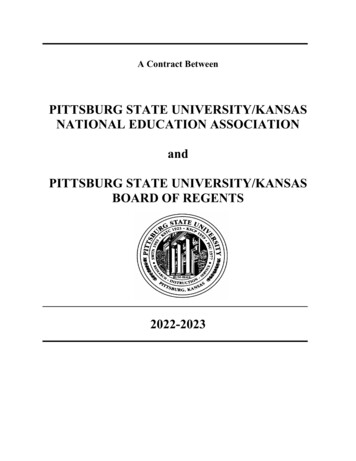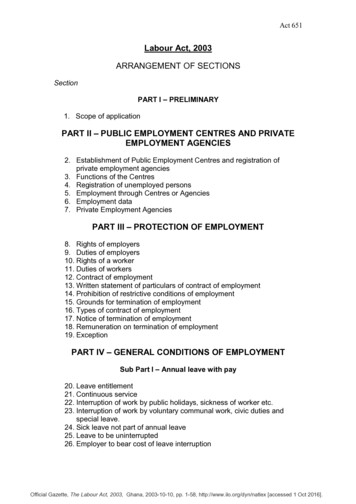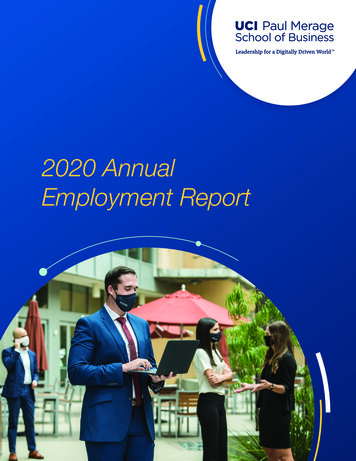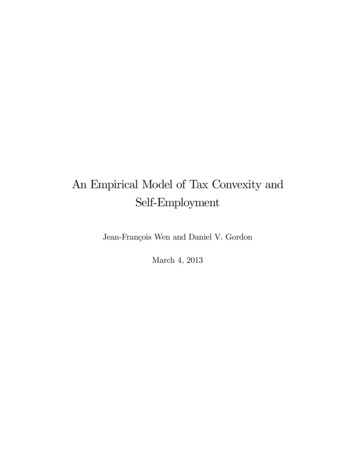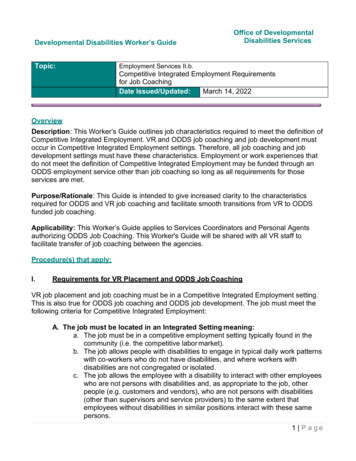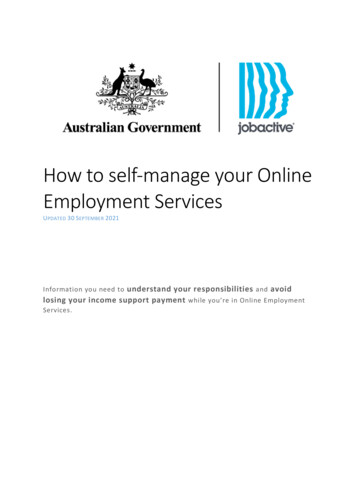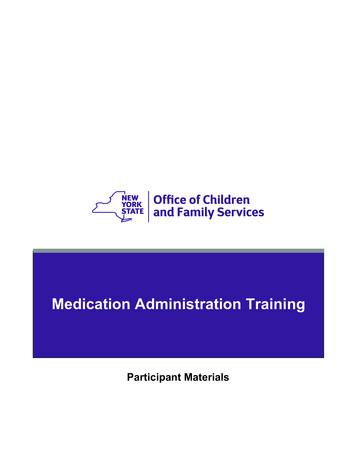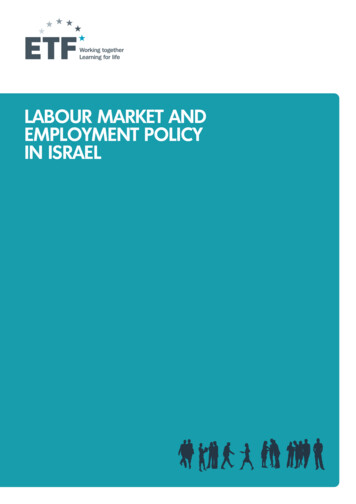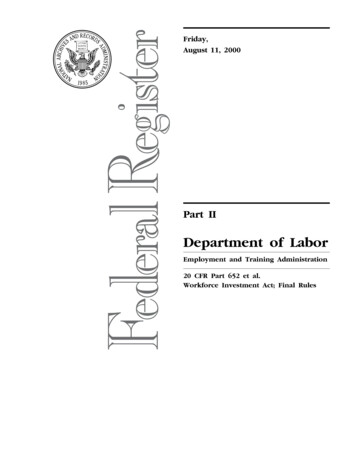
Transcription
Friday,August 11, 2000Part IIDepartment of LaborEmployment and Training Administration20 CFR Part 652 et al.Workforce Investment Act; Final RulesVerDate 11 MAY 200010:44 Aug 10, 2000Jkt 190000PO 00000Frm 00001Fmt 4717Sfmt 4717E:\FR\FM\11AUR2.SGMpfrm03PsN: 11AUR2
49294Federal Register / Vol. 65, No. 156 / Friday, August 11, 2000 / Rules and RegulationsTelephone: (202) 219–7831 (voice) (thisis not a toll-free number) or 1–800–326–2577 (TDD).SUPPLEMENTARY INFORMATION:DEPARTMENT OF LABOREmployment and TrainingAdministration20 CFR Part 652 and Parts 660 through671RIN 1205–AB20Workforce Investment ActAGENCY: Employment and TrainingAdministration (ETA), Labor.ACTION: Final rule.SUMMARY: The Department of Labor(DOL) is issuing a Final Ruleimplementing provisions of titles I, IIIand V of the Workforce Investment Act.Through these regulations, theDepartment implements major reformsof the nation’s job training system andprovides guidance for statewide andlocal workforce investment systems thatincrease the employment, retention andearnings of participants, and increaseoccupational skill attainment byparticipants, and as a result, improvethe quality of the workforce, reducewelfare dependency, and enhance theproductivity and competitiveness of theNation. Key components of this reforminclude streamlining services through aOne-Stop service delivery system,empowering individuals throughinformation and access to trainingresources through Individual TrainingAccounts, providing universal access tocore services, increasing accountabilityfor results, ensuring a strong role forLocal Boards and the private sector inthe workforce investment system,facilitating State and local flexibility,and improving youth programs.DATES: This Final Rule will becomeeffective on September 11, 2000.ADDRESSES: All comments receivedduring the comment period followingthe publication of the Interim Final Rule(64 FR 18662, et seq., Apr. 15, 1999) areavailable for public inspection andcopying during normal business hoursat the Employment and TrainingAdministration, Office of CareerTransition Assistance, 200 ConstitutionAvenue, NW., Room S–4231,Washington, DC 20210. Copies of theFinal Rule are available in alternateformats of large print and electronic fileon computer disk, which may beobtained at the above-stated address.The Final Rule is also available on theWIA web site at http://usworkforce.org.FOR FURTHER INFORMATION CONTACT: Mr.Eric Johnson, Office of Career TransitionAssistance, U.S. Department of Labor,200 Constitution Avenue, NW., RoomS–4231, Washington, DC 20210,VerDate 11 MAY 200010:44 Aug 10, 2000Paperwork Reduction ActThis Final Rule does not add any newinformation collection requirements tothose of the Interim Final Rule. Certainsections of this Final Rule, such as§§ 667.300, 667.900, 668.800, and669.570 contain information collectionrequirements. These requirements havenot been changed. Under the PaperworkReduction Act of 1995 (44 U.S.C.3507(d)), the Department of Laborsubmitted a copy of these sections to theOffice of Management and Budget forreview. No comments were receivedabout and no changes have been madeto the information collectionrequirements.We have prepared documentsproviding guidance on specificinformation collection requirements. Asrequired by the Paperwork ReductionAct of 1995 (44 U.S.C. 3507(d)), wesubmitted these documents to the Officeof Management and Budget (OMB) forits review. Affected parties do not haveto comply with the informationcollection requirements contained inthis document until we publish in theFederal Register the control numbersassigned by the Office of Managementand Budget. Publication of the controlnumbers notifies the public that OMBhas approved this informationcollection requirement under thePaperwork Reduction Act of 1995. Forfurther information contact: Ira Mills,Departmental Clearance Officer,Department of Labor, 200 ConstitutionAvenue, NW., Washington, DC 20210,(202) 219–5095, ext. 143.I. BackgroundA. WIA PrinciplesOn August 7, 1998, President Clintonsigned the Workforce Investment Act of1998 (WIA), comprehensive reformlegislation that supersedes the JobTraining Partnership Act (JTPA) andamends the Wagner-Peyser Act. WIAalso contains the Adult Education andFamily Literacy Act (title II) and theRehabilitation Act Amendments of 1998(title IV). Guidance or regulationsimplementing titles II and IV will beissued by the Department of Education.WIA reforms Federal job trainingprograms and creates a new,comprehensive workforce investmentsystem. The reformed system isintended to be customer-focused, tohelp Americans access the tools theyneed to manage their careers throughinformation and high quality services,Jkt 190000PO 00000Frm 00002Fmt 4701Sfmt 4700and to help U.S. companies find skilledworkers. This new law embodies sevenkey principles. They are: Streamlining services through betterintegration at the street level in the OneStop delivery system. Programs andproviders will co-locate, coordinate andintegrate activities and information, sothat the system as a whole is coherentand accessible for individuals andbusinesses alike. Empowering individuals in severalways. First, eligible adults are givenfinancial power to use IndividualTraining Accounts (ITA’s) at qualifiedinstitutions. These ITA’s supplementfinancial aid already available throughother sources, or, if no other financialaid is available, they may pay for all thecosts of training. Second, individualsare empowered with greater levels ofinformation and guidance, through asystem of consumer reports providingkey information on the performanceoutcomes of training and educationproviders. Third, individuals areempowered through the advice,guidance, and support available throughthe One-Stop system, and the activitiesof One-Stop partners. Universal access. Any individualwill have access to the One-Stop systemand to core employment-relatedservices. Information about jobvacancies, career options, studentfinancial aid, relevant employmenttrends, and instruction on how toconduct a job search, write a resume, orinterview with an employer is availableto any job seeker in the U.S., or anyonewho wants to advance his or her career. Increased accountability. The goalof the Act is to increase employment,retention, and earnings of participants,and in doing so, improve the quality ofthe workforce to sustain economicgrowth, enhance productivity andcompetitiveness, and reduce welfaredependency. Consistent with this goal,the Act identifies core indicators ofperformance that State and local entitiesmanaging the workforce investmentsystem must meet—or suffer sanctions.However, State and local entitiesexceeding the performance levels canreceive incentive funds. Trainingproviders and their programs also haveto demonstrate successful performanceto remain eligible to receive funds underthe Act. And participants, with theirITA’s, have the opportunity to maketraining choices based on programoutcomes. To survive in the market,training providers must makeaccountability for performance andcustomer satisfaction a top priority. Strong role for local workforceinvestment boards and the privatesector, with local, business-led boardsE:\FR\FM\11AUR2.SGMpfrm03PsN: 11AUR2
Federal Register / Vol. 65, No. 156 / Friday, August 11, 2000 / Rules and Regulationsacting as ‘‘boards of directors,’’ focusingon strategic planning, policydevelopment and oversight of the localworkforce investment system. Businessand labor have an immediate and directstake in the quality of the workforceinvestment system. Their activeinvolvement is critical to the provisionof essential data on what skills are indemand, what jobs are available, whatcareer fields are expanding, and theidentification and development ofprograms that best meet local employerneeds. Highly successful privateindustry councils under JTPA exhibitthese characteristics now. Under WIA,this will become the norm. State and local flexibility. Statesand localities have increased flexibility,with significant authority reserved forthe Governor and chief elected officials,to build on existing reforms in order toimplement innovative andcomprehensive workforce investmentsystems tailored to meet the particularneeds of local and regional labormarkets. Improved youth programs linkedmore closely to local labor market needsand community youth programs andservices, and with strong connectionsbetween academic and occupationallearning. Youth programs includeactivities that promote youthdevelopment and citizenship, such asleadership development throughvoluntary community serviceopportunities; adult mentoring andfollowup; and targeted opportunities foryouth living in high poverty areas.Many States and local areas havealready taken great strides inimplementing these principles,supported by grants from theDepartment of Labor (DOL) to buildOne-Stop service delivery systems andschool-to-work transition systems. TheAct builds on these reforms and ensuresthat they will be available throughoutthe country.We wish to emphasize that DOLconsiders the reforms embodied in theWorkforce Investment Act to be pivotal,and not ‘‘business as usual.’’ Thislegislation provides an unprecedentedopportunity for major reforms that canresult in a reinvigorated, integratedworkforce investment system. Statesand local communities, together withbusiness, labor, community-basedorganizations, educational institutions,and other partners, must seize thishistoric opportunity by thinkingexpansively as they design a customerfocused, comprehensive deliverysystem.The success of the reformedworkforce investment system isdependent on the development of trueVerDate 11 MAY 200010:44 Aug 10, 2000partnerships and honest collaboration atall levels and among all stakeholders.While the Workforce Investment Actand these regulations assign specificroles and responsibilities to specificentities, for the system to realize itspotential necessitates moving beyondcurrent categorical configurations andinstitutional interests. Also, it isimperative that input is received fromall stakeholders and the public at eachstage of the development of State andlocal workforce investment systems.The cornerstone of the new workforceinvestment system is One-Stop servicedelivery which unifies numeroustraining, education and employmentprograms into a single, customerfriendly system in each community. Theunderlying notion of One-Stop is thecoordination of programs, services andgovernance structures so that thecustomer has access to a seamlesssystem of workforce investmentservices. We envision that a variety ofprograms could use common intake,case management and job developmentsystems in order to take full advantageof the One-Stops’ potential for efficiencyand effectiveness. A wide range ofservices from a variety of training andemployment programs will be availableto meet the needs of employers and jobseekers. The challenge in making OneStop live up to its potential is to makesure that the State and Local Boards caneffectively coordinate and collaboratewith the network of other serviceagencies, including TANF agencies,transportation agencies and providers,metropolitan planning organizations,child care agencies, nonprofit andcommunity partners, and the broadrange of partners who work with youth.B. Rule FormatThe format, as well as the substance,of the Final Rule, reflects theAdministration’s commitment toregulatory reform and to writingregulations that are reader-friendly. Wehave attempted to make theseregulations clear and easy tounderstand, as well as to anticipateissues that may arise and to provideappropriate direction. To this end, theregulatory text is presented in a‘‘question and answer’’ format. We haveorganized the regulations in a way thatwill help those implementing the newsystem to recognize the various stepsthat must be taken to develop theorganization and services that make upthe workforce investment system. Inmany cases, the provisions of WIA arenot repeated in these regulations. Inresponse to comments, however, wedetermined that, in a number ofinstances, the regulations wouldJkt 190000PO 00000Frm 00003Fmt 4701Sfmt 470049295provide context and be more readerfriendly if the Act’s provisions wereincluded in an answer rather thanmerely cross-referencing the statute.C. Prior ActionsSince the passage of the WorkforceInvestment Act in August of 1998, wehave used a variety of means to initiateextensive coordination with otherFederal agencies that have roles andresponsibilities under WIA. In addition,the Department of Labor, theDepartment of Education, theDepartment of Health and HumanServices, the Department ofTransportation, and the Department ofHousing and Urban Developmentcontinue to meet on a regular basis toresolve issues surrounding WIAimplementation.Before publishing the Interim FinalRule, we also requested and receivedinput from a broad range of sourcesabout how to structure guidance on howto comply with a number of WIAstatutory provisions. We solicited broadinput on WIA implementation througha variety of mechanisms: establishing aweb site to encourage input; publishinga Federal Register notice on September15, 1998; conducting regional andnational panel discussions in October1998; publishing a White Paperannouncing goals and principlesgoverning implementation; postingissues on the usworkforce.org web site;sharing a discussion draft of regulatoryissues with stakeholders; holding townhall meetings across the country inDecember 1998; conducting severalworkgroups in December 1998; issuingdraft Planning Guidance in December1998; and conducting a series of WIAImplementation Technical AssistanceConferences across the country inMarch and April of 1999.On April 15, 1999, the Interim FinalRule was published in the FederalRegister, at 64 FR 18662 through 18764,and a 90-day comment periodcommenced. We continued to provideinformation by posting questions andanswers on the usworkforce.org website; publishing a series of consultationpapers in April, May and August of1999, on defining and measuringperformance, incentives and sanctions,customer satisfaction, and continuousimprovement; conducting a secondround of Town Hall meetings across thecountry in August of 1999; and hosting‘‘Voice of Experience’’ forums inFebruary and March of 2000 wherepractitioners shared insights andsuggestions for successfulimplementation of WIA. An InterimFinal Rule implementing section 188nondiscrimination and equalE:\FR\FM\11AUR2.SGMpfrm03PsN: 11AUR2
49296Federal Register / Vol. 65, No. 156 / Friday, August 11, 2000 / Rules and Regulationsopportunity provisions of WIA, codifiedin 29 CFR part 37, was publishedseparately in the Federal Register, at 64FR 61692 through 61738, Nov. 12, 1999.Comments received on those regulationswill be addressed in the preamble tothat Final Rule.We reviewed every comment receivedduring the comment period followingpublication of the Interim Final Rule, aswell as the experience of earlyimplementing States, and suggestionsreceived from partners and stakeholderswhen considering whether the FinalRule should differ from the InterimFinal Rule. These comments arediscussed in the Summary andExplanation of the individual provisionsof the Final Rule. Section 506(c)(1) ofthe Act required the Secretary of Laborto issue this Final Rule implementingprovisions of the WIA under theDepartment’s purview by December 31,1999. While we were unable to meetthis deadline, we have endeavored toissue this Final Rule as expeditiously aspossible without compromising thequality of the document. UnderSecretary of Labor’s Order No. 4–75, theAssistant Secretary for Employment andTraining has been delegated theresponsibility to carry out WIA policies,programs, and activities for theSecretary of Labor. We have determinedthat this Final Rule, as promulgated,complies with the WIA statutorymandate to issue a Final Rule andprovides effective direction for theimplementation of WIA programs.II. Summary and ExplanationThis section contains our response tocomments received on the Interim FinalRule during the comment period. Thecomments are discussed at considerablelength in order to make clear ourinterpretation of WIA through thesefinal regulations and of their applicationto some of the challenges that may arisein implementing the Act.We have set regulations only wherethey are necessary to clarify or toexplain how we intend to interpret theWIA statute, to provide context forinterpretations or to provide a clearstatement of the Act’s requirements. Inseveral instances—for example, theIndian and Native American Programs,and Migrant and Seasonal FarmworkerPrograms—the regulations weredeveloped in consultation with advisorycouncils and are more comprehensive inorder to assist those grantees. Consistentwith the Act, the Final Rule providesthe States and local governments withthe primary responsibility to initiateand develop program implementationprocedures and policy guidanceregarding WIA administration.VerDate 11 MAY 200010:44 Aug 10, 2000There are a limited number of changesin the Final Rule because of ourcommitment to allowing maximumflexibility at the State and local level.Section 661.120 formalizes thisflexibility in the regulations. A numberof comments suggested that we specifycertain groups of providers andparticipants and types of activities innumerous sections of the regulations.Among others, these commentssuggested revising the regulations to:add new definitions, and additionalState and local planning requirements;require States and locals to consult withspecific organizations in order to fulfillthe public comment processrequirements; and identify certain typesof programs, providers or participants,such as service learning opportunities,and nontraditional employment andtraining opportunities for women anddislocated homemakers, in matterswhere States and localities havediscretion to define terms and makeother discretionary decisions. Toprovide policy-making flexibility toStates and local areas and to avoidsuggesting that any one group or activityis more important than those nothighlighted in the regulations, we havegenerally not made those changes.However, we do believe thatconsultation with and inclusion of thesegroups is important to obtaining theoptimal functioning of the cooperativesystem envisioned by WIA. We fullyexpect that States and local areas willconsult broadly before adopting plansand policies; and that their workforceinvestment systems will be structured toinclude all providers and programs thatmay help meet the needs of theirpopulations, and equitably serve allpopulation segments within theirservice areas.In addition to the changes made basedupon the comments received, in order toclarify policy and interpretation andimprove upon the Rule’s reader-friendlyformat, we have also made technicalchanges to correct typographical errors,such as consistent capitalization,abbreviations, grammatical correctionsand citations, and for consistency withthe regulations implementing thenondiscrimination and equalopportunity provisions of WIA section188, which were first published in theFederal Register on November 12, 1999(64 FR 61692 through 61738, 29 CFRpart 37).When publishing a Final Rulefollowing a comment period, it iscustomary to publish only changesmade to the rule, however, in order tobe more user-friendly, we are publishingthe entire Rule, including those partsthat have not been changed, for WIAJkt 190000PO 00000Frm 00004Fmt 4701Sfmt 4700titles I and V. This means that onedocument which contains all of theregulations and commentary may beconsulted rather than needing tocompare various documents. Similarly,the new Wagner-Peyser regulations atpart 652 subpart C are republished infull.Description of Regulatory ProvisionsPart 660—Introduction to theRegulations for the WorkforceInvestment Systems Under Title I of theWorkforce Investment ActPart 660 discusses the purpose of titleI of the Workforce Investment Act andexplains the format of the regulationsgoverning title I.A few commenters suggested we addthe attainment of self-sufficiency to thedescription of the purpose of title I in§ 660.100.Response: While we agree that theattainment of self-sufficiency is animportant goal of workforce investmentsystems under title I of the Act, we havenot added that phrase to the regulationsince the current language tracks section106 of the Act.Part 660 also provides definitionswhich are not found in the Act, as wellas some of the statutory definitions wefelt should be added for emphasis orclarification. Sections 101, 142, 166(b),167(h) 301 and 502 of the Act containadditional definitions. We receivedseveral comments on the definitionscontained in § 660.300. One commentersuggested that we add ‘‘youth’’ to thedefinition of ‘‘employment and trainingactivity’’.Response: The three terms,‘‘workforce investment activity,’’‘‘employment and training activity,’’and ‘‘youth activity,’’ are defined insection 101 of WIA. We have not added‘‘youth’’ to the definition of‘‘employment and training activity’’since employment and trainingactivities are a separate subset ofworkforce investment activities undertitle I, Chapter 5 of the Act. Workforceinvestment activities are the array ofactivities permitted under title I of WIA,which include employment and trainingactivities for adults and dislocatedworkers, and youth activities.A commenter requested that wedefine the term ‘‘labor federation’’ asused in relation to nominationrequirements for labor representatives tothe State and Local Boards, stating ‘‘[i]tis our understanding that [this term] isintended to include AFL-CIO StateFederations, State Building andConstruction Trades Councils, AFL-CIOCentral Labor Councils, and LocalE:\FR\FM\11AUR2.SGMpfrm03PsN: 11AUR2
Federal Register / Vol. 65, No. 156 / Friday, August 11, 2000 / Rules and RegulationsBuilding and Construction TradeCouncils.’’Response: We have added a definitionof the term ‘‘labor federation’’, similar tothat used in JTPA, which will includethese groups within that term.We received several comments on thedefinition of ‘‘literacy’’. One commentersuggested that the definition of‘‘literacy’’ be expanded to mean theability to read, write and speak inEnglish or an individual’s nativelanguage, if that is not English.Response: In order to promoteconsistency among Federal Programs,title I, section 101(19) of WIA defines‘‘literacy’’ by stating that it is the samedefinition used in title II, section203(12) of the Act. Section 660.300 ofthe regulations restates this definitionfor the convenience of the reader.Literacy is defined as the ‘‘ability toread, write, and speak in English,compute and solve problems, at thelevels of proficiency necessary tofunction on the job, in the family of theindividual and in society.’’ No changehas been made to this statutorydefinition.Another commenter suggested thatthe term ‘‘literacy’’ be amended toinclude computer literacy since it is animportant and necessary workplaceskill.Response: We agree that computerliteracy is a key skill, however, as statedabove, no changes have been made tothe definition of ‘‘literacy’’ since it is astatutory definition found in section203(12) of title II of WIA.Among the regulatory definitions, wehave defined the term ‘‘register’’ inorder to clarify that programs do notneed to register participants until theyreceive a core service beyond those thatare self-service or informational. Thispoint in time also corresponds to thepoint when the participants are countedfor performance measurement purposes.A few commenters suggested that theterm ‘‘register’’ be redefined to requireall adults and dislocated workers whoreceive services, including those whoonly receive self-service orinformational services, to be registeredin order to track universal participationin the workforce investment system.Response: The process of registrationis designed to signal when an individualis counted against the core measures ofperformance title I programs. Since theAct exempts informational and selfservice activities from the coremeasures, we are not requiringindividuals who only receive thoseservices to be registered. However,States and local areas are authorized tocollect information beyond what isrequired at the Federal level. In MarchVerDate 11 MAY 200010:44 Aug 10, 20002000, we issued Training andEmployment Letter (TEGL) 7–99 whichprovides additional guidance on thepoint of registration. This guidance canbe found on the Internet atwww.usworkforce.org. Additionaldiscussion of this issue is contained inpart 663 and part 664 of theseregulations. Part 666 provides newguidelines on when a service isdetermined to be self-service orinformational. Finally, whileparticipants may not need to beregistered until they receive coreservices for performance measurementpurposes, recipients must collect equalopportunity data regarding anyindividual who has submitted personalinformation in response to a request bythe recipient for such information. See29 CFR 37.4 (definitions of ‘‘applicant’’and ‘‘registrant’’), and § 37.37(b)(2).Another commenter suggested thatthe term ‘‘register’’ be more clearlydefined, and requested a description ofthe differences between registration,enrollment and participation.Response: While we have not changedthe definition of ‘‘register,’’ additionalguidance on the registration process andits connection to the performanceaccountability system can be found inTEGL 7–99, as well as part 663 and part664 of these regulations. In general,‘‘enrollment’’ is not a term that is beingused in the WIA title I performancesystem. An individual who registers forservices is determined eligible and iscounted against the core indicators ofperformance. This registered individualis considered a participant whilereceiving services (except followupservices) funded under subtitle B ofWIA title I.This commenter also suggested thatwe clarify that information oncitizenship and selective service statusbe collected at the time of registration.Response: In addition to any otherstatutory or regulatory requirements,under WIA section 188(a)(5)—‘‘Prohibition on Discrimination AgainstCertain Non-Citizens’’—participation inprograms or activities, or receivingfinancial assistance under WIA title I,must be available to citizens andnationals of the United States, lawfullyadmitted permanent resident aliens,refugees, asylees, and parolees and otherimmigrants authorized to work in theUnited States. Compliance with thenon-discrimination provisions of WIA isaddressed in the Interim FinalRegulations promulgated by theDepartment’s Civil Rights Center at 29CFR part 37 (64 FR 61692, November12, 1999). A discussion of theseprovisions can be found in the preambleJkt 190000PO 00000Frm 00005Fmt 4701Sfmt 470049297discussion of 29 CFR 37.37(b)(2), at 64FR 61705.Section 189 of WIA provides that theMilitary Selective Service Act (50 U.S.C.App. 453) must be complied with toreceive any assistance or benefit undertitle I. In order to allow the greatestpossible flexibility in the provision ofservices, we will not dictate specificways to comply with thisstraightforward requirement.Several commenters suggested addingdefinitions of ‘‘contract’’ and‘‘commercial organization’’ or ‘‘forprofit entity’’ and modifying thedefinitions of ‘‘grant,’’ ‘‘subrecipient,’’and ‘‘vendor’’ to ensure consistencywith the Federal Grant and CooperativeAgreement Act, (31 U.S.C. 6301), and toreduce confusion about what awards aresubject to the uniform procurementrequirements at 29 CFR 95.40 through95.48 and 29 CFR 97.36, and whatawards are not subject to theserequirements.Response: We have decided not toadd definitions of ‘‘contract,’’‘‘commercial organization’’ or ‘‘forprofit entity’’, because these terms aredefined or discussed in theDepartment’s rules on uniformadministrative requirements at 29 CFRparts 95 and 97 (the ‘‘Common Rules’’),as well as in the Department’s rules onaudit requirements for grantees in 29CFR parts 96 and 99, all of which areincorporated by reference at 20 CFR667.200. We are modifying thedefinitions of ‘‘subrecipient’’ and‘‘vendor’’ to cross-reference thediscussion in the DOL auditrequirements, at 29 CFR 99.210, whichcontrasts the differences betweensubrecipients and vendors. Since thedefinition of ‘‘grant’’ in § 660.300, isalready quite specific as to the types oforganizations which may be awardedgrants, we consider changes to this termto be unnecessary. We also aremodifying the definition of ‘‘recipient’’to indicate that the term refers to theentire legal entity receiving the award,not just the particular componentwithin that entity which is designatedin the award document. Themodification is consistent with thedefinition of ‘‘recipient’’ in the JTPAregulations at 20 CFR 626.5 and thedefinition of ‘‘grantee’’ in the CommonRule at 29 CFR 97.3. Also, we arereiterating the Common Rule’sdefinition of the term ‘‘subgrant’’ for theconvenience of the reader.Another commenter suggesteddefining the term ‘‘obligation’’ so thatIndividual Training Account (ITA)commitments could be treated asobligations for purposes of thereallotment and reallocation proceduresE:\FR\FM\11AUR2.SGMpfrm03PsN: 11AUR2
49298Federal Register / Vol. 65, No. 156 / Friday, August 11, 2000 / Rules and Regulationsof 20 CFR §§ 667.150 and 667.160, eventhough they might not meet thestandards of obligation used byparticular State or local governments.Response: Section 667.150 of theregulations provides for recapture by theSecretary of unobligated balances fromStates with unobligated balances whichexceed 20 percent of the amountallotted in the previous program year,after adjustment for amounts reservedby a State for administration andamounts transferred by the Statebetween youth and adult funds.Reallotment is then made to Stateswhich have obligated at least 80 percentof the amounts allotted in the previousprogram year, after adjustment fortransfers and amounts reserved foradministration. Section 667.160 coversthe recapture and reallocation ofamounts wi
49294 Federal Register/Vol. 65, No. 156/Friday, August 11, 2000/Rules and Regulations DEPARTMENT OF LABOR Employment and Training Administration 20 CFR Part 652 and Parts 660 through 671 RIN 1205-AB20 Workforce Investment Act AGENCY: Employment and Training Administration (ETA), Labor.
